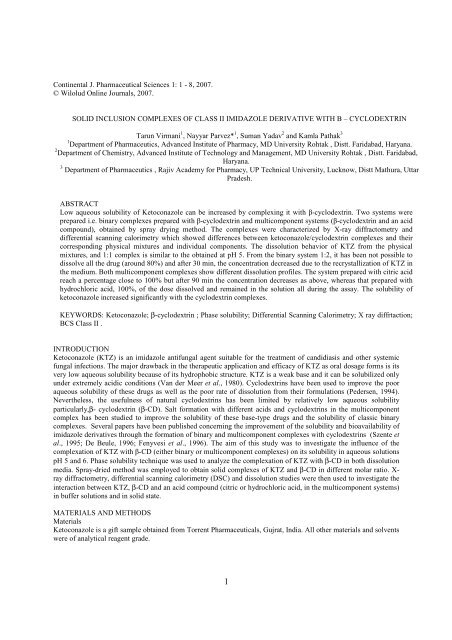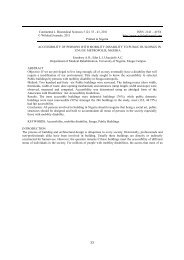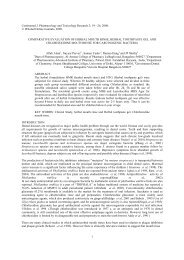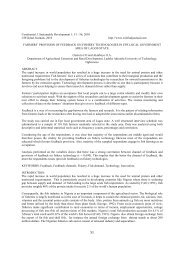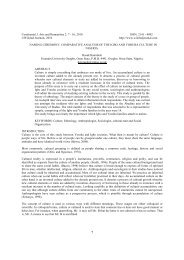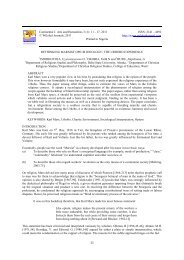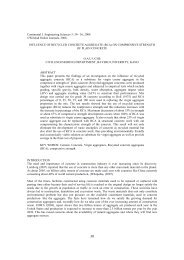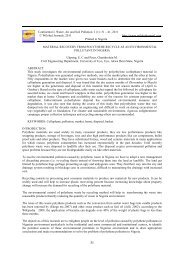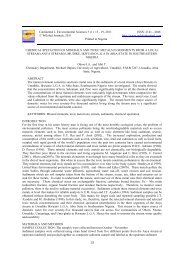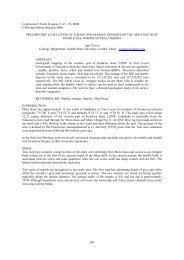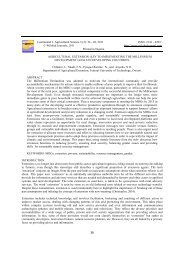Vol. 1-Cont. J. Pharm Sci solid - Wilolud Journals
Vol. 1-Cont. J. Pharm Sci solid - Wilolud Journals
Vol. 1-Cont. J. Pharm Sci solid - Wilolud Journals
Create successful ePaper yourself
Turn your PDF publications into a flip-book with our unique Google optimized e-Paper software.
<strong>Cont</strong>inental J. <strong>Pharm</strong>aceutical <strong>Sci</strong>ences 1: 1 - 8, 2007.<br />
© <strong>Wilolud</strong> Online <strong>Journals</strong>, 2007.<br />
SOLID INCLUSION COMPLEXES OF CLASS II IMIDAZOLE DERIVATIVE WITH Β – CYCLODEXTRIN<br />
Tarun Virmani 1 , Nayyar Parvez* 1 , Suman Yadav 2 and Kamla Pathak 3<br />
1 Department of <strong>Pharm</strong>aceutics, Advanced Institute of <strong>Pharm</strong>acy, MD University Rohtak , Distt. Faridabad, Haryana.<br />
2 Department of Chemistry, Advanced Institute of Technology and Management, MD University Rohtak , Distt. Faridabad,<br />
Haryana.<br />
3 Department of <strong>Pharm</strong>aceutics , Rajiv Academy for <strong>Pharm</strong>acy, UP Technical University, Lucknow, Distt Mathura, Uttar<br />
Pradesh.<br />
ABSTRACT<br />
Low aqueous solubility of Ketoconazole can be increased by complexing it with β-cyclodextrin. Two systems were<br />
prepared i.e. binary complexes prepared with β-cyclodextrin and multicomponent systems (β-cyclodextrin and an acid<br />
compound), obtained by spray drying method. The complexes were characterized by X-ray diffractometry and<br />
differential scanning calorimetry which showed differences between ketoconazole/cyclodextrin complexes and their<br />
corresponding physical mixtures and individual components. The dissolution behavior of KTZ from the physical<br />
mixtures, and 1:1 complex is similar to the obtained at pH 5. From the binary system 1:2, it has been not possible to<br />
dissolve all the drug (around 80%) and after 30 min, the concentration decreased due to the recrystallization of KTZ in<br />
the medium. Both multicomponent complexes show different dissolution profiles. The system prepared with citric acid<br />
reach a percentage close to 100% but after 90 min the concentration decreases as above, whereas that prepared with<br />
hydrochloric acid, 100%, of the dose dissolved and remained in the solution all during the assay. The solubility of<br />
ketoconazole increased significantly with the cyclodextrin complexes.<br />
KEYWORDS: Ketoconazole; β-cyclodextrin ; Phase solubility; Differential Scanning Calorimetry; X ray diffrtaction;<br />
BCS Class II .<br />
INTRODUCTION<br />
Ketoconazole (KTZ) is an imidazole antifungal agent suitable for the treatment of candidiasis and other systemic<br />
fungal infections. The major drawback in the therapeutic application and efficacy of KTZ as oral dosage forms is its<br />
very low aqueous solubility because of its hydrophobic structure. KTZ is a weak base and it can be solubilized only<br />
under extremely acidic conditions (Van der Meer et al., 1980). Cyclodextrins have been used to improve the poor<br />
aqueous solubility of these drugs as well as the poor rate of dissolution from their formulations (Pedersen, 1994).<br />
Nevertheless, the usefulness of natural cyclodextrins has been limited by relatively low aqueous solubility<br />
particularly,β- cyclodextrin (β-CD). Salt formation with different acids and cyclodextrins in the multicomponent<br />
complex has been studied to improve the solubility of these base-type drugs and the solubility of classic binary<br />
complexes. Several papers have been published concerning the improvement of the solubility and bioavailability of<br />
imidazole derivatives through the formation of binary and multicomponent complexes with cyclodextrins (Szente et<br />
al., 1995; De Beule, 1996; Fenyvesi et al., 1996). The aim of this study was to investigate the influence of the<br />
complexation of KTZ with β-CD (either binary or multicomponent complexes) on its solubility in aqueous solutions<br />
pH 5 and 6. Phase solubility technique was used to analyze the complexation of KTZ with β-CD in both dissolution<br />
media. Spray-dried method was employed to obtain <strong>solid</strong> complexes of KTZ and β-CD in different molar ratio. Xray<br />
diffractometry, differential scanning calorimetry (DSC) and dissolution studies were then used to investigate the<br />
interaction between KTZ, β-CD and an acid compound (citric or hydrochloric acid, in the multicomponent systems)<br />
in buffer solutions and in <strong>solid</strong> state.<br />
MATERIALS AND METHODS<br />
Materials<br />
Ketoconazole is a gift sample obtained from Torrent <strong>Pharm</strong>aceuticals, Gujrat, India. All other materials and solvents<br />
were of analytical reagent grade.<br />
1
Tarun Virmani et al: <strong>Cont</strong>inental J. <strong>Pharm</strong>aceutical <strong>Sci</strong>ences 1: 1 - 8, 2007.<br />
Table No. 1 – Formulations of Ketoconazole and their complexes in different ratios<br />
S.No. Complex Prepared Ratio used<br />
1 KTZ: PM (Physical Mixture) 1:1<br />
2 KTZ- βCD 1:1<br />
3 KTZ-βCD 1:2<br />
4 KTZ-βCD-HCL 1:2:2<br />
5 KTZ-βCD-CITRIC ACID 1:2:1<br />
Fig. 1. Phase solubility diagrams of ketoconazole and β-cyclodextrin in buffer pH 5 and 6 at 37°C.<br />
Phase solubility studies<br />
Solubility diagrams were obtained according to Higuchi and Connors (1965) in phosphate buffer solutions of pH 5<br />
and 6. Excess KTZ was added to vials containing various concentrations of β-CD. The vials were shaken in a water<br />
bath at 37°C until equilibrium was reached (7 days). The content of each vial was filtered (0.22 pm pore size) and<br />
the concentration of KTZ in the filtered solutions was measured by UV spectrophotometry at 225 nm. The apparent<br />
stability constant of the KTZ-β-CD complex, assuming 1:1 constant, were calculated from the slope of the initial<br />
straight portion of the phase solubility diagrams as<br />
KH = slope/S0(1 - slope)<br />
2
Tarun Virmani et al: <strong>Cont</strong>inental J. <strong>Pharm</strong>aceutical <strong>Sci</strong>ences 1: 1 - 8, 2007.<br />
Fig. 2. Powder X-ray diffraction patterns of the different KTZ-βCD systems: (a) βCD; (b) KTZ; (c) physical mixture<br />
(1:1 ); (d) physical mixture ( 1:2); (e) K TZ-βCD (1 : 1 ) complex; (f) KTZ-βCD (1:2) complex; (g) KTZ-βCD-HCI<br />
(1:2:2) complex; (h) KTZ-βCD-Citric acid (1:2:1) complex.<br />
where So is the solubility of the pure drug (Higuchi and Connors, 1965). All the data are the average of three<br />
determinations.<br />
Preparation and characterization of <strong>solid</strong> inclusion complexes and physical mixtures<br />
The <strong>solid</strong> complexes of KTZ-β-CD (1:1, 1:2, molar ratio) and KTZ-β-CD with hydrochloric or citric acid (1:2:2,<br />
1:2:1, molar ratio) was prepared using the spray-drying method as follows: KTZ and β-CD in adequate molar ratio<br />
dissolved in ethanol and water, respectively, were mixed before spray drying. Multicomponent complexes were<br />
obtained from an aqueous solution of KTZ, β-CD and hydrochloric or citric acid. Physical mixtures of an<br />
appropriate amount of KTZ and β-CD were obtained by pulverizing and thereafter mixing both <strong>solid</strong>s in a mixer (5<br />
min at 30 rpm). Powder X-ray diffraction patterns were carried out with a Philips X-ray diffractometer (PW 1710<br />
BASED) using Cu-K radiation. Thermal analysis was performed using a Shimadzu DSC-50 system with a<br />
differential scanning calorimeter equipped with a computerized data station (scanning rate 10°C/min).<br />
3
Tarun Virmani et al: <strong>Cont</strong>inental J. <strong>Pharm</strong>aceutical <strong>Sci</strong>ences 1: 1 - 8, 2007.<br />
Fig. 3. Differential scanning calorimetry of the different KTZ-βCD systems: (a) βCD; (b) KTZ; (c) physical mixture<br />
(1:1 ); (d) physical mixture ( 1:2); (e) K TZ-βCD (1 : 1 ) complex; (f) KTZ-βCD (1:2) complex; (g) KTZ-βCD-HCI<br />
(1:2:2) complex; (h) KTZ-βCD-Citric acid (1:2:1) complex<br />
Dissolution studies<br />
Dissolution rates of KTZ, physical mixtures and the inclusion complexes were determined (Nogami et al 1969), in<br />
phosphate buffer solutions of pH 5 and 6 as the dissolution medium, at 37°C for 180 min. The samples,<br />
corresponding to 30 mg of KTZ, were placed in 100 ml of the dissolution medium and shaken at 500 rpm. The<br />
concentration of the drug was determined by UV spectrophotometer at 225 nm. All samples were analyzed in<br />
triplicate. Dissolution efficiencies after 180 min were calculated (Khan, 1975). The effects of drug formulation on<br />
dissolution efficiency at each pH were investigated by one-way analysis of variance with the Scheffe test for<br />
multiple comparisons by using graph pad prism software.<br />
4
Tarun Virmani et al: <strong>Cont</strong>inental J. <strong>Pharm</strong>aceutical <strong>Sci</strong>ences 1: 1 - 8, 2007.<br />
Fig. 4. Dissolution profiles of KET and its inclusion complexes at pH 5: (a) KET; (b) physical mixture (l:1); (c)<br />
physical mixture (1:2); (d) KET-BCD (1:1) complex; (e) KET-BCD (1:2) complex; (f) KET-BCD-HCI (1:2:2)<br />
complex; (g) KETBCD- Citric acid (1:2:1) complex.<br />
RESULTS AND DISCUSSION<br />
Interaction between KTZ and β-CD in aqueous media<br />
Phase solubility profiles of KTZ with β-CD are shown in Fig. 1. Both diagrams can be classified as AL type<br />
according to Higuchi and Connors (1965). This indicates that the aqueous solubility of the drug increases linearly as<br />
a function of β-CD concentration and a soluble complex is formed. Stability constants for the complex calculated<br />
from the slope of the initial straight portion of the solubility diagram were 1051.9 M -1 at pH 5 and 6959.3 M -1 at pH<br />
6. From these values a different interaction in both media between the drug and the cyclodextrin can be deduced.<br />
The ionization of ketoconazole decrease with pH and, for this reason, the interaction with β-CD is better at pH 6.<br />
Drug cyclodextrin complexation has been found to be better with unionized drug (Otero Espinar et al., 1989).<br />
5
Tarun Virmani et al: <strong>Cont</strong>inental J. <strong>Pharm</strong>aceutical <strong>Sci</strong>ences 1: 1 - 8, 2007.<br />
Fig. 5. Dissolution profiles of KET and its inclusion complexes at pH 6: (a) KTZ; (b) physical mixture (1:1); (c)<br />
physical mixture (1:2); (d) KTZ-βCD (1:1) complex; (e) KTZ-βCD (1:2) complex; (f) KTZ-βCD-HCl (1:2:2)<br />
complex; (g) KTZ- βCD- Citric acid (1:2:1) complex.<br />
Characterization of <strong>solid</strong> complexes<br />
The X-ray diffractograms of KTZ-βCD binary and multicomponent complexes in comparison with the physical<br />
mixtures are shown in the Fig. 2. The diffraction patterns of the physical mixtures correspond to the superimposed<br />
diffractograms of KTZ and βCD, while those of the spray-dried complexes show fewer and less intense peaks. This<br />
indicates that all spray-dried compounds are markedly less crystalline than the physical mixtures or the pure<br />
components. Fig. 3 shows the DSC thermograms of the physical mixtures of the KTZ and βCD as well as those of<br />
the <strong>solid</strong> binary and multicomponent complexes prepared by the spray-drying method. The physical mixtures show<br />
two endothermic peaks at 100°C (corresponding to the loss of the water content of βCD) and 149°C (due to melting<br />
of the drug). However, these peaks disappeared in the case of all complexes prepared by spray-drying. These results<br />
can be explained on the basis of a better interaction among the drug and the cyclodextrin, indicating the<br />
complexation of KTZ with βCD. X-ray and DSC studies indicate the formation of amorphous complexes between<br />
the cyclodextrin and the drug.<br />
6
Tarun Virmani et al: <strong>Cont</strong>inental J. <strong>Pharm</strong>aceutical <strong>Sci</strong>ences 1: 1 - 8, 2007.<br />
Effects of complexation on dissolution of the drug<br />
Fig. 4 illustrates the dissolution profiles obtained with pure KTZ, physical mixtures and the inclusion complexes in<br />
buffer solution pH 5. One-way ANOVA in dissolution efficiency (0-180 min) reveals significant differences<br />
between the different formulations (F(6, 14) = 2379.708, α< 0.01). The Sheffe test grouped the formulations are given<br />
in table no. 1. Physical mixtures of KTZ with βCD showed a higher dissolution rate than pure KTZ and, this effect<br />
increases with the amount of βCD in the mixture. In the binary systems as the amount of β-CD raises in the<br />
complexes, a better dissolution profile is shown. Nevertheless, no differences were found among the binary system<br />
1:2 and the multicomponent complexes, prepared with the same molar ratio of β-CD. This fact is probably due to the<br />
ionization of the drug in this medium. In buffer solution pH 6, the behavior of the prepared systems defers from the<br />
above at pH 5 (Fig. 5). The solubility of KTZ is lower because ionization decreases. For this reason, total amount of<br />
KTZ dissolved from all the preparations is lower than at pH 5. Therefore, in spite of the higher stability constant<br />
calculated at pH 6, the effect of cyclodextrins on drug solubility is lower than in the more acidic medium. Analysis<br />
of variance indicates that the 'formulation' affects significantly 0-180-min dissolution efficiency (F(6,14)= 754.308, α<br />
Received for Publication: 12/07/2007<br />
Accepted for Publication: 07/09/2007<br />
Tarun Virmani et al: <strong>Cont</strong>inental J. <strong>Pharm</strong>aceutical <strong>Sci</strong>ences 1: 1 - 8, 2007.<br />
Corresponding Author:<br />
Dr Nayyar Parvez,<br />
Department of <strong>Pharm</strong>aceutics.<br />
Email ID: nparvez1975@yahoo.co.in<br />
nayyarparvez@rediffmail.com<br />
8


